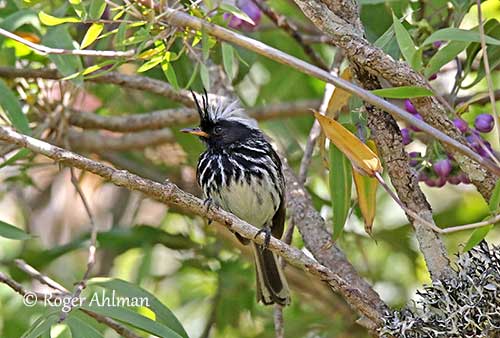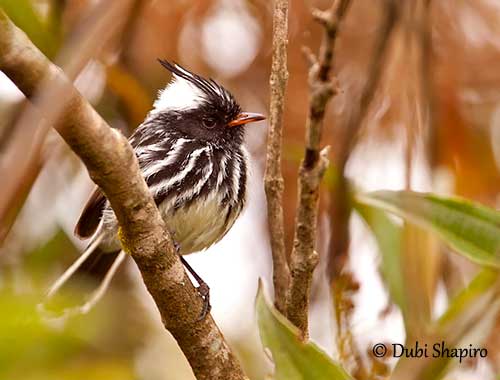
Fr: Taurillon à cimier noir
Ang: Black-crested Tit-Tyrant - Marañon Tit Tyrant
All: Schwarzhauben-Tachurityrann
Esp: Cachudito Crestinegro
Ita: Tiranno cincia crestanera
Nd: Zwartkuifmeestiran
Sd: svarttofsad mestyrann
Photographers:
Roger Ahlman
Pbase Galleries Peru and Ecuador & My bird pictures on IBC
Dubi Shapiro
Dubi Shapiro Photo Galleries & Dubi Shapiro's Pictures on IBC
Text by Nicole Bouglouan
Sources:
HANDBOOK OF THE BIRDS OF THE WORLD Vol 9 - by Josep del Hoyo - Andrew Elliot - David Christie - Lynx Edicions - ISBN: 8487334695
BIRDS OF SOUTH AMERICA – Passerines - by Robert S. Ridgely and Guy Tudor – HELM Field Guides – ISBN: 9781408113424
Neotropical Birds – Cornell Lab of Ornithology
CREAGUS@Monterey Bay (Don Roberson)
Wikipedia, the free encyclopaedia
Black-crested Tit-Tyrant
Anairetes nigrocristatus
Passeriformes Order – Tyrannidae Family
INTRODUCTION:
The Black-crested Tit-Tyrant is included in the family Tyrannidae, subfamily Elaeniinae. The species of genus Anairetes are strictly found in temperate or arid scrub habitats and mainly in the Andes. The name ‘tit-tyrant” refers to the prominent crest and active perch-gleaning foraging behaviour, often reminiscent of Paridae species.
The Black-crested Tit-Tyrant is found in S Ecuador and N Peru where it frequents scrubby habitats and Polylepis woodland at high elevation (2,300/4,200 metres). It is the largest of the genus Anairetes and shows very bold black-and-white markings.
The Black-crested Tit-Tyrant is rare to locally common, but the species is not currently threatened.

DESCRIPTION OF THE BIRD:
Biometrics:
Length: 13 cm
The Black-crested Tit-Tyrant male has black upperparts with narrow white streaks. The black wings show two white wingbars, formed by the broad white tips of the wing-coverts. The secondaries have white edges except at base, but the white edges are broader on the innermost flight-feathers. The tail is black with broad white tips, usually broader on outermost rectrices which also have white outer webs.
On the underparts, throat, breast and flanks are streaked black-and-white, whereas belly and undertail-coverts are pale yellowish.
The head is black with greatly elongated central crown feathers, forming thin, bifurcated crest. There is an extensive white patch on crown and nape. Forehead, face and chin are black.
The bill is bright orange with blackish tip. The eyes are dark brown. Legs and feet are black.
The males found in Ecuador have more extensive black on throat and breast.
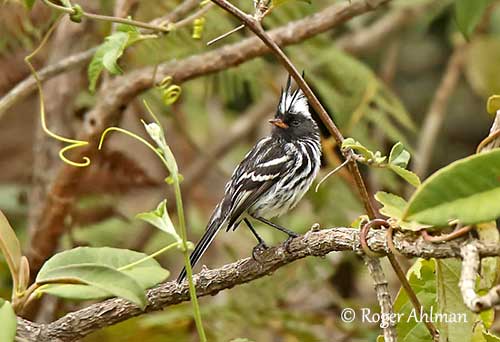
The female has similar plumage, but her crest is shorter and the forehead is duller black. The remaining black-and-white pattern is mostly dusky-and-whitish. The bill is usually black with orange-yellow base of lower mandible.
The juvenile has shorter crest and its crown is dusky. The lores are buffy and we can see a partial eyering. The back is streaked blackish and pale olivaceous. The underparts are less white, with faint dark brown streaks on breast. The bill is dark with flesh-coloured base of lower mandible.
RANGE:
The Black-crested Tit-Tyrant occurs in extreme S Ecuador (S Loja) and N Peru (Cajamarca S to E Ancash and W Huánuco).
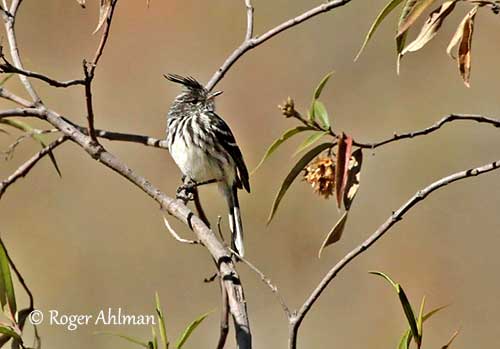
HABITAT:
The Black-crested Tit-Tyrant frequents scrubby areas and woodland, including patches of Polylepis in the Andes. It can be seen in dense scrubby vegetation along streams or bordering ravines. The species occurs at high-elevation, between 2,300 and 4,200 metres. It can be seen locally around 2,000 metres of elevation.
CALLS AND SONGS: SOUNDS BY XENO-CANTO
The Black-crested Tit-Tyrant gives fast series of harsh notes “tree-tr-ri-i-i-i-i-i-tr-r-reu” trailing off at the end. We can also hear a shorter version of this call “tree-tr-iiii”.
BEHAVIOUR IN THE WILD:
The Black-crested Tit-Tyrant is an insect-eater. It forages actively, flying from stem to stem, usually almost at top of dense brush. It stops while adopting horizontal to vertical posture, and it may sometimes flick its tail upwards. It catches prey from leaves and twigs, but rarely in aerial sallies.
This species is usually seen alone or in small groups, and it may sometimes follow mixed-species foraging groups including Tufted Tit-Tyrant (A. parulus).
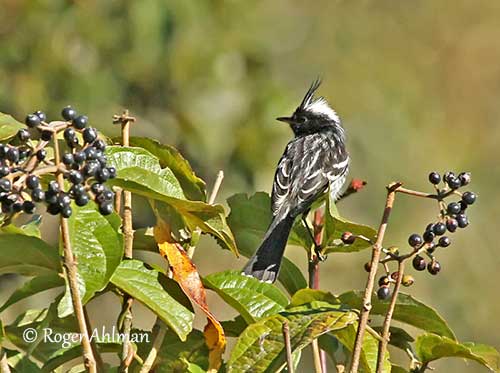
The breeding behaviour is unknown. But as male and female have similar appearance, we can suggest that the pairs are monogamous and defend a territory. The prominent crest probably plays a role during the displays, being raised to expose the white crown/nape patch.
The Black-crested Tit-Tyrant is resident in its range.
It is agile in flight while foraging, performing short flights from stem to stem.
REPRODUCTION OF THIS SPECIES:
The breeding season occurs apparently in June-July.
In the family Tyrannidae, the female is usually more active than the male, building the nest and incubating the eggs.
She lays 2-4 or 2-6 eggs and the incubation ranges between 12 and 16 days, sometimes up to 23 days in the smaller species. The chicks are fed by both parents. They fledge between 12 and 24 days after hatching, depending on the species.
PROTECTION / THREATS / STATUS:
The Black-crested Tit-Tyrant is described as uncommon or local, although it can be common in National Parks in Peru.
The population is apparently stable and the Black-crested Tit-Tyrant is currently evaluated as Least Concern.
